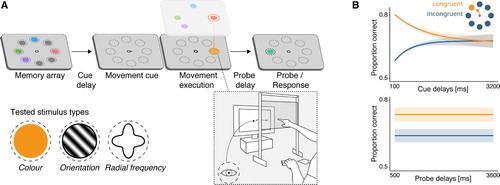Figures & data
Figure 1. Prioritisation of action-relevant locations. (A) In a typical paradigm, participants have to memorise a set of items (here, four colours) and perform an eye or hand movement to a cued location during the maintenance interval. Memory and movement tasks are unrelated, that is, the movement cue is not predictive of the upcoming memory probe location. The movement is accompanied by the automatic allocation of attention (orange) to the goal location, and the item representation that is spatially congruent with the movement goal benefits from the increased attentional engagement at that location. (B) As a result, memory performance for congruent (i.e., action-relevant) items is better than for incongruent (i.e., action-irrelevant) items. This effect is largest shortly after encoding and decreases with increasing cue delay (top panel), but remains stable for several seconds once action-related priorities have been established (i.e., across different probe delays following movement execution; bottom panel). These plots illustrate typical results; for the original data see Hanning & Deubel, Citation2018; Hanning et al., Citation2016; Heuer et al., Citation2017; Heuer & Schubö, Citation2018; Ohl and Rolfs (Citation2017, Citation2018, Citation2020).

Figure 2. Prioritisation of action-relevant feature dimensions. (A) In a typical paradigm, participants memorise a set of items defined by different feature dimensions (here, size and colour) and are cued to prepare a grasping or pointing movement during the maintenance interval, but to withhold movement execution until after completion of the memory task at the end of the trial. Memory and movement tasks are unrelated, that is, the movement type is not predictive of the upcoming memory probe type. The different movement types render different features action-relevant: While size is a relevant feature dimension for grasping, colour can be used to guide a pointing movement. Item representations defined along action-relevant feature dimensions benefit from their increased attentional weight (yellow for grasping, green for pointing). (B) As a result, memory performance for size items is better during the preparation of a grasp, whereas performance for colour items tends to be slightly better while a pointing movement is being prepared. This plot illustrates typical results; for the original data see Heuer and Schubö (Citation2017).

